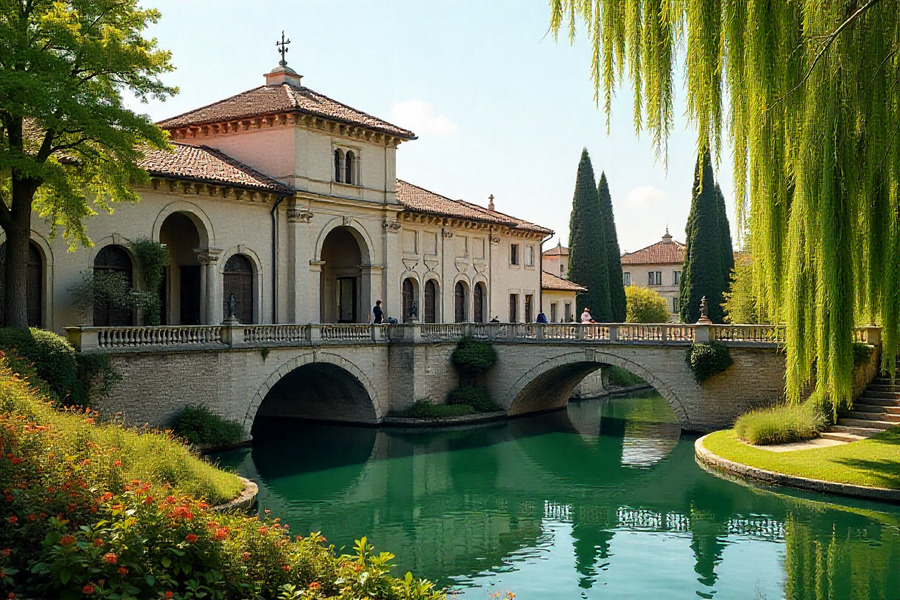Home » TRAVEL NEWS » Spain, Portugal Linked By El Marco, A Tiny Wooden Bridge That Lets You Walk From One Country To Another In Seconds—and Travel One Hour Into The Future
Monday, August 4, 2025
Spain and Portugal are joined by one of the world’s most unique border crossings—a modest six-meter wooden bridge known as El Marco. Spanning the narrow Abrilongo stream, this tiny structure not only links two countries but also crosses a time zone, pushing clocks forward by one hour when moving from Portugal to Spain. Far more than a simple footpath, the bridge stands as a symbol of centuries-old cultural ties, daily exchanges, and peaceful coexistence between neighboring communities on either side of the Iberian frontier.
El Marco: The Tiny Wooden Bridge Linking Portugal and Spain Across Borders and Time
In the quiet borderlands between Portugal and Spain lies one of the world’s most curious and symbolic crossings: the El Marco Bridge. Located near the Portuguese town of Arronches in the Portalegre District, this tiny wooden footbridge connects the village of La Codosera in Spain to the parish of Esperança in Portugal. Although modest in appearance, measuring only six meters in length and just under one and a half meters in width, it holds the unique title of being the smallest international bridge in the world.
The bridge spans the gentle Abrilongo stream, a modest waterway that serves as a natural border between the neighboring nations of Portugal and Spain on the Iberian Peninsula. It was constructed in 2008 to replace a series of makeshift walkways that had historically served the residents of both nations. Before the current structure existed, locals used a fragile wooden crossing that was often swept away during seasonal floods, especially in the wetter months. That temporary bridge had connected generations of families, traders, and workers who traveled back and forth for both necessity and neighborly interaction.
Unlike larger border crossings designed for vehicle traffic and commerce, El Marco only supports pedestrians, bicycles, and two-wheeled vehicles such as scooters and motorbikes. Its simplicity, however, doesn’t diminish its importance. On the contrary, this bridge has served as a lifeline for border communities—an understated but vital connector in a region where cultural and familial ties transcend national divisions.
Historically, this site played a central role in grassroots trade between Portuguese and Spanish villagers. Long before formal trade agreements and open-border policies, the people of La Codosera and Esperança had created their own system of informal exchange. Portuguese families brought everyday goods such as coffee, towels, and household items, while their Spanish counterparts offered wine, cutlery, and other essentials. The Abrilongo stream may have been a political boundary, but for the people who lived near it, the border was more of a bridge than a barrier.
These exchanges were more than economic—they were deeply personal. Over the decades, generations formed friendships and even intermarried across the two sides. The bridge eventually became not just a crossing point but a cultural emblem. It quietly symbolized mutual reliance, shared heritage, and a way of life that valued cooperation over division.
The current El Marco Bridge was made possible with support from the European Union, part of a broader initiative to strengthen rural connectivity and preserve cross-border relationships in small communities. The bridge’s construction came at a time when both countries were already benefiting from the Schengen Agreement, which eliminated routine border checks across much of Europe. With no need for passports or customs controls, locals and tourists alike could cross freely, further reinforcing the bond between the two regions.
Beyond its historical and social value, El Marco also serves as a quirky geographic and temporal landmark. Due to the time zone difference between Spain and Portugal, walking across the bridge technically moves you forward or backward in time by one hour. Spain operates on Central European Time (CET), while Portugal remains on Greenwich Mean Time (GMT). So, if you cross from Portugal into Spain, you are instantly an hour ahead—an oddity that has become a point of fascination for visitors.
During the summer dry season, the Abrilongo stream often dwindles to a gentle trickle, prompting locals to joke that a bridge isn’t even necessary—you could simply jump across. But despite the seasonal shallowness of the stream, the bridge remains a fixture of the landscape, used daily by both residents and tourists.
Today, El Marco has gained recognition not just for its small size but for its symbolic weight. Travelers from around the world visit to experience walking from one country into another in a matter of seconds, to marvel at the idea of “time travel” caused by a simple step across a plank, or to take photos at one of Europe’s most charming international borders. The bridge may not be grand in scale, but it offers an experience that few other places can match.
In many ways, El Marco stands as a testament to the idea that borders do not always have to divide—they can also unite. In a world where discussions about borders often revolve around control, separation, or conflict, this little wooden bridge offers a refreshing counterpoint. It represents peaceful coexistence, shared history, and the human connections that often outlast political boundaries.
Spain and Portugal are connected by a six-meter bridge that quietly crosses not just a national border but also a time zone—offering a rare journey through geography and history in mere seconds.
Though modest and often overlooked on the map, El Marco is a powerful symbol of Europe’s interconnectedness. For those who visit, it’s not just about crossing a small bridge between Portugal and Spain—it’s about stepping into a story of unity, cooperation, and timeless neighborly friendship.
